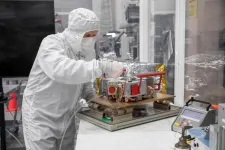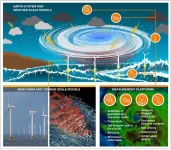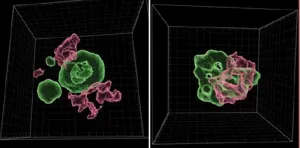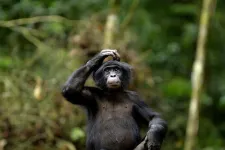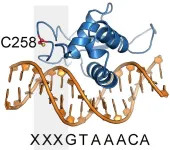(Press-News.org) In Miami—a place known for one of the most diverse tree canopies in the world—nearly half of the native trees may struggle to survive in the coming decades, a new University of Miami study indicates.
Due to global warming, temperatures may simply become too hot for some of the types of trees that dominate the city’s current landscape, like live oaks, slash pines, and cabbage palms.
But the research also found that strategically planting more tropical trees may help the local canopy stay resilient in the face of climate change.
Through an extensive data analysis project, a team of ecologists in the Department of Biology in the College of Arts and Sciences discovered that up to 41 percent of the tree species planted throughout Miami-Dade County’s urban core will likely experience heat stress by 2100 as temperatures climb beyond the species’ heat tolerances. This means that many of South Florida’s native trees will be more susceptible to disease and death. Yet, the team also found that many of the exotic tree species from the Caribbean and the tropics could thrive in a warmer Miami.
“Between 16 and 41 percent of tree species currently planted in Miami will eventually be living in temperatures that are beyond what we know they can survive in,” said Alyssa Kullberg, a doctoral graduate in biology who is the lead author on the paper published in Urban Forestry and Urban Greening. “Now that we have this information, we can think about the tree species we should be planting into the future.”
Over the past year, Kullberg worked with biology professor Kenneth Feeley, along with other graduate students in his Jungle Biology Lab, to create a list of the 249 most common tree species found in the urban Miami core, and then calculated their “thermal safety margin,” or how much heat they can tolerate. From that data, they determined that many of the region’s native shade trees, like oaks, slash pine, bald cypress, and red maple may not be able to endure the high temperatures that South Florida will likely experience over the coming decades. Therefore, planting trees native to the tropics that are capable of tolerating hotter temperatures will be a better long-term option, Feeley said.
“We can’t keep planting for the conditions we have today,” added Feeley, Smathers Chair of Tropical Tree Biology and director of the University’s John C. Gifford Arboretum, in a recent presentation to the Dade Chapter of the Florida Native Plant Society.
Kullberg, Feeley and Riley Fortier, three of the authors of this study. Photo courtesy of Kenneth Feeley.
Toward that goal, the study offers specific suggestions based on their research. While there are many exotic palms that can thrive in hot temperatures, Kullberg and Feeley recognize that planting palms may not offer sufficient shade to counteract the heat island effect present in large urban areas like Miami. The team also factored in other stressors like changes in wind, droughts, and saltwater incursions that Miami will likely encounter in the future. This led them to suggest planting trees that are native to Miami but that also occur throughout the Caribbean, and that also offer shade, such as black olive, West Indian mahogany, gumbo-limbo, and sea grape trees.
“As temperatures rise, it will have a disproportionate impact on our native temperate species, whereas tropical and exotic species will be more comfortable,” Feeley added. “We can think of Miami as being part of the Caribbean and plant trees that come from the greater Caribbean.”
Kullberg and Feeley have spent time working with stakeholders, like Silvi, a reforestation nonprofit with interest in South Florida, and have spoken to various botanical organizations. Kullberg also met with Miami-Dade County chief heat officer Jane Gilbert, who was interested in their suggestions for the county’s tree planting initiative.
“One of the great outcomes of this work was that we got involved with all of these local stakeholders who are interested in improving the health of Miami’s urban tree communities,” said Kullberg, now a postdoctoral researcher at the Swiss Federal Institute of Technology Lausanne.
The team also created a research method that can be used by others to identify the best tree species for localities across the world in the coming years. Kullberg said that she hopes this work will spur other cities to be proactive about planting more resilient trees.
“Urban heat is a really major public health concern. So given that, we wanted to shed light on the need for forward-thinking plantings to help take care of urban tree communities and ensure that they are providing the services and benefits that we need, like mitigating the heat island effect while also absorbing carbon dioxide and offsetting greenhouse gas emissions,” she said.
END
The trees of Miami’s future
New research indicates that to keep Miami’s tree canopy resilient, tropical species may be the best option for local municipalities and environmental leaders to consider
2024-10-15
ELSE PRESS RELEASES FROM THIS DATE:
MIT team takes a major step toward fully 3D-printed active electronics
2024-10-15
CAMBRIDGE, MA – Active electronics — components that can control electrical signals — usually contain semiconductor devices that receive, store, and process information. These components, which must be made in a clean room, require advanced fabrication technology that is not widely available outside a few specialized manufacturing centers.
During the Covid-19 pandemic, the lack of widespread semiconductor fabrication facilities was one cause of a worldwide electronics shortage, which drove up costs for consumers and had implications in everything from economic growth to national defense. The ability to 3D print an entire, active electronic ...
Accelerated three-year medical school students perform as well as peers in traditional four-year programs
2024-10-15
Graduates who went to medical school for three years performed equally well on tests of skill and knowledge as their peers who followed a four-year program, a new study shows.
The accelerated three-year MD pathway offered by NYU Grossman School of Medicine beginning in 2013 was designed to help students earn their medical degrees sooner with reduced debt, which some experts say reaches $250,000 on average by graduation. The school was the first in the United States to offer a three-year MD program that ...
SwRI-developed instruments will study potential habitability of Jupiter’s moon Europa
2024-10-15
SAN ANTONIO — October 15, 2024 —Two Southwest Research Institute instruments were launched aboard NASA’s Europa Clipper spacecraft on Oct. 14 from the agency’s Kennedy Space Center. The spacecraft is designed to conduct a detailed reconnaissance of Jupiter’s moon Europa, investigating whether it could hold conditions suitable for life.
The SwRI-developed MAss Spectrometer for Planetary EXploration (MASPEX) and Ultraviolet Spectrograph (Europa-UVS) are among nine science instruments and a gravity science investigation that were developed to explore Europa, Jupiter’s fourth-largest ...
Proposed scoring system may enhance equity in organ transplantation, increase transplant rates and improve patient survival
2024-10-15
Tuesday, Oct. 15, 2024, Cleveland: Researchers at Cleveland Clinic and Case Western Reserve University (CWRU) have developed a new method that could potentially help provide better access to lung transplant for transplant candidates who are hard to match because of their blood type or height.
An analysis published in the Journal of Heart & Lung Transplantation showed significant inequity in lung transplant access based on these candidate characteristics and proposes a method for addressing it.
Lung transplant candidates require organs from donors of similar height and compatible blood type. Currently, to allow equally sick candidates equal ...
Survivors of childhood brain cancer are more likely to be held back in school
2024-10-15
In 2019, Raymond Mailhot was visiting with a young patient and his family facing a scary diagnosis – brain cancer. Treatments were incredibly effective, and the young boy was going to survive, Mailhot shared in Spanish with the Venezuelan immigrants.
But life would be disrupted at home, at the hospital, and at school, likely for months, he said.
“His story really made me want to dig deeper into the scholastic performance of survivors,” said Mailhot, M.D., M.P.H, an associate professor of radiation oncology at the University of Florida. “We discovered that survivors had twice the odds of being held back and performed significantly worse on state testing ...
Updating offshore turbine designs to reflect storms’ complexity is key
2024-10-15
WASHINGTON, Oct. 15, 2024 – The U.S. is ramping up plans for a major increase in offshore wind production, with 30 gigawatts of new installations expected by 2030 and a total of 110 gigawatts by 2050. But to be successful, the country needs to design turbines that can withstand the challenges of tropical storms.
“Extreme weather impacts on offshore wind turbines are not fully understood by the industry,” author Jiali Wang said. “Manufacturers design wind turbines based on international design standards, but better models and data are needed to study the impacts of extreme weather ...
Hospital strain during the COVID-19 pandemic and outcomes in older racial and ethnic minority adults
2024-10-15
About The Study: In this cross-sectional study, older adults hospitalized with sepsis were more likely to die or experience major morbidity as the hospital COVID-19 burden increased. These increases in adverse outcomes were greater in magnitude among members of minority populations than for white individuals.
Corresponding Author: To contact the corresponding author, Laurent G. Glance, MD, email laurent_glance@urmc.rochester.edu.
To access the embargoed study: Visit our For The Media website at this link https://media.jamanetwork.com/
(doi:10.1001/jamanetworkopen.2024.38563)
Editor’s Note: Please see the article for additional information, ...
Scientists unveils key role of “selfish DNA” in early human development
2024-10-15
A critical transition in early human development is regulated not by our own genes, but by DNA elements called transposons that can move around the genome, Sinai Health researchers have found.
This remarkable discovery challenges our previous understanding of these elusive DNA segments, shedding new light on the roles they play in human development and disease.
“People tend to think of transposons as akin to viruses where they hijack our cells for the sole purpose of propagating themselves,” says study’s senior co-author Dr. Miguel Ramalho-Santos, Senior Investigator at the Lunenfeld-Tanenbaum Research Institute (LTRI), part of Sinai Health, and Professor ...
Bonobos may be more vulnerable than previously thought, suggests genetics study
2024-10-15
Bonobos, endangered great apes that are among our closest relatives, might be more vulnerable than previously understood, finds a genetics study led by a UCL researcher that reveals three distinct populations.
The three groups of bonobos have been living separately in different regions in Central Africa for tens of thousands of years, according to the study published in Current Biology by an international research team co-led by UCL, University of Vienna, and Max Planck Institute for Evolutionary Anthropology ...
Scripps Research scientists discover chemical probes for previously “undruggable” cancer target
2024-10-15
LA JOLLA, CA—Hormone-driven cancers, like those of the breast and prostate, often rely on a tricky-to-target protein called Forkhead box protein 1 (FOXA1). FOXA1 mutations can enable these types of cancers to grow and proliferate. Today, FOXA1 is notoriously difficult to block with drugs—but that may soon change.
Scripps Research scientists have identified a crucial binding site on FOXA1 that could pave the way for future cancer treatments. The team’s findings, which were published in Molecular Cell on October 15, 2024, also mapped out how tiny drug-like chemical compounds—called small molecules—interact with the protein.
While ...
LAST 30 PRESS RELEASES:
Learning about public consensus on climate change does little to boost people’s support for action, study shows
Sylvester Cancer Tip Sheet for January 2026
The Global Ocean Ship-Based Hydrographic Investigations Program (GO-SHIP) receives the Ocean Observing Team Award
Elva Escobar Briones selected for The Oceanography Society Mentoring Award
Why a life-threatening sedative is being prescribed more often for seniors
Findings suggest that certain medications for Type 2 diabetes reduce risk of dementia
UC Riverside scientists win 2025 Buchalter Cosmology Prize
SETI Institute opens call for nominations for the 2026 Tarter Award
Novel theranostic model shows curative potential for gastric and pancreatic tumors
How beige fat keeps blood pressure in check
Fossils reveal ‘latitudinal traps’ that increased extinction risk for marine species
Review: The opportunities and risks of AI in mental health research and care
New map reveals features of Antarctic’s ice-covered landscape
Beige fat promotes healthy vascular function and blood pressure in mice
Chronic low-dose pesticide exposure reduces the life span of wild lake fish, China-based study shows
Tiny earthquakes reveal hidden faults under Northern California
Long-term pesticide exposure accelerates aging and shortens lifespan in fish
Professor Tae-Woo Lee's research group develops groundbreaking perovskite display technology demonstrating the highest efficiency and industry-level operational lifetime
The “broker” family helps tidy up the cell
Ecology: Mummified cheetahs discovery gives hope for species’ Arabic reintroduction
Researchers survey the ADHD coaching boom
Air pollution and cardiac remodeling and function in patients with breast cancer
Risk of suicide in patients with traumatic injuries
Post–intensive care syndrome
The lifesaving potential of opioid abatement funds
The Frontiers of Knowledge Award goes to Allan MacDonald and Pablo Jarillo-Herrero for their discovery of the “magic angle” enabling science to transform and control the behavior of new materials
Discovery reveals how keto diet can prevent seizures when drugs fail
JMIR Publications and Sikt announce pilot flat-fee unlimited open access partnership
Finding new cell markers to track the most aggressive breast cancer in blood
A new, cleaner way to make this common fertilizer
[Press-News.org] The trees of Miami’s futureNew research indicates that to keep Miami’s tree canopy resilient, tropical species may be the best option for local municipalities and environmental leaders to consider


